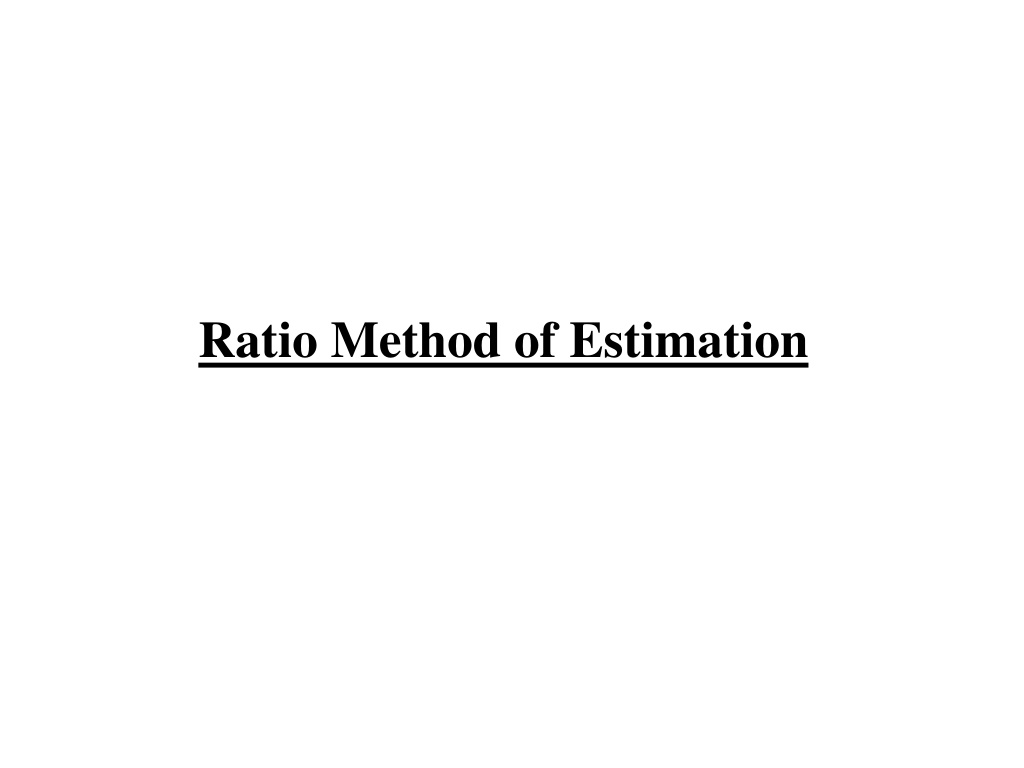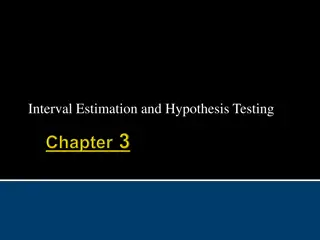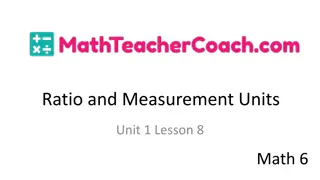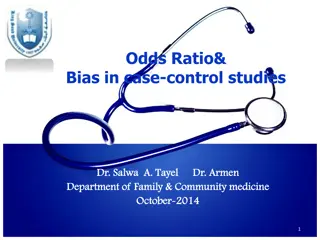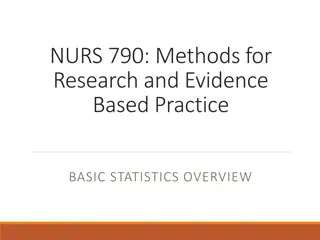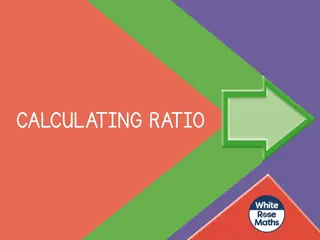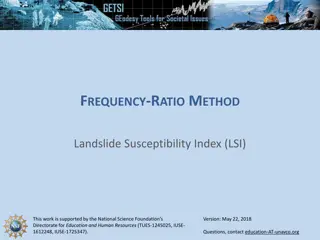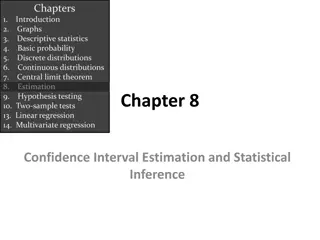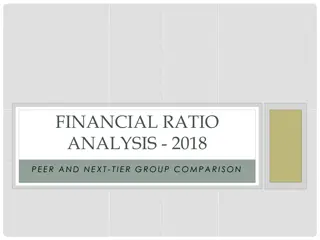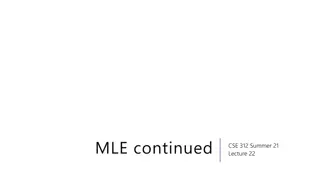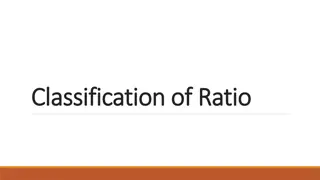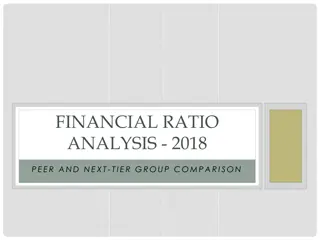Ratio Method of Estimation in Statistics
The Ratio Method of Estimation in statistics involves using supplementary information related to the variable under study to improve the efficiency of estimators. This method uses a benchmark variable or auxiliary variable to create ratio estimators, which can provide more precise estimates of population totals compared to simple estimation methods. Ratio estimators have properties such as bias and consistency, being more effective with larger sample sizes and high correlation between the benchmark variable and the estimand.
Download Presentation

Please find below an Image/Link to download the presentation.
The content on the website is provided AS IS for your information and personal use only. It may not be sold, licensed, or shared on other websites without obtaining consent from the author.If you encounter any issues during the download, it is possible that the publisher has removed the file from their server.
You are allowed to download the files provided on this website for personal or commercial use, subject to the condition that they are used lawfully. All files are the property of their respective owners.
The content on the website is provided AS IS for your information and personal use only. It may not be sold, licensed, or shared on other websites without obtaining consent from the author.
E N D
Presentation Transcript
If ancillary or supplementary information is available for each of the units of the population, it can under suitable conditions, be used in several ways to improve the efficiency of the estimators of the variable under investigation (estimand). The supplementary information must be correlated with the variable under study. This method of estimation is usually appreciated and generally gives more precise estimates regarding population total as compared to the simple estimation method. The supplementary information usually referred to as benchmark variable or Auxiliary Variable.
The term ratio estimation applies to a widely used class of estimation plan which incorporates the prior information including individual values, which is closely related to the variable under investigation for all units of the population. Such situations arise very frequently in practice, especially where the variables under consideration are the current level of some economic variable (such as retail sales) and the results of a survey giving some previous level of that variable. Ratio estimators can be formed corresponding to any selection plan, but in this Chapter attention will be confined to simple and stratified random sampling. Ikeda- Mizuno-Sen- Lahiri selection procedure in which the first unit is selected with probability proportional to the measure of size and remaining n-1 units with equal probability and without replacement will also be described. This makes the ratio estimator unbiased of population total Y.
Ratio estimator contains bias and consistent. It is applicable when sample size is large. Ratio estimator has the following properties: ratio estimator is generally biased, but the bias decreases as the sample size increases as in case of unbiased estimation and the distribution of r tends to normality (this is a property of consistent estimator), and the mean square error of ratio estimator is smaller than that of unbiased estimator, if there is high correlation between benchmark variable and estimand.
Ratio Method of Estimation A method of estimation in which we use some additional information related to the current variable of the study as ratio is called the ratio method of estimation and the estimator is called the ratio estimator. The additional variable is generally called a bench mark variable and is denoted by X . The ratio estimator of population total is given ??= ? =? ? ? ? ? ? (Mean) Where ??= x = Total of sample from X y = Total of sample from Y X = Total of population from X Condition under which ratio estimator is more precise than simple estimator ??? ?? < ???( ?) That s why more efficient and skewed
Ratio Method of Estimation Theorem: Find ??? ?? = ? and ??? ?? = ? Proof: Let us define ??= ? ? ??= ? ?
Ratio Method of Estimation ?2??2 ?2 ? ????? +??2??2 ?2 (? ?)2= ??2+ 2 ?2?(??2) ?2 ? ??(????) 2) + ?(? ?)2= ?(?? 2 ??? ?? ?? ??? ?? =(1 ?) 2 2???? 2+ ?2?? ?? ? Theorem ??? ?? =??? ? ? ?????) (???+ ???? ?? ??? ? =?(? ?) ??? ? Prove that ratio estimator will be more precise than the simple estimator.
Ratio Method of Estimation Proof: ??? ?? < ??? ? ?2? ? ?? 2 2???? <?(? ?) 2+ ?2?? 2 ?? ?? ? 2 2????< ?? 2+ ?2?? 2 ?? 2 2????< 0 ?2?? 2< 2???? ?2?? 2< 2???????? ?2?? ???>??? 2??
Ratio Method of Estimation ? ? 2?? ?? ???> ?? ? ???>1 2 . ?? ? ?.?(?) 2?.?(?) ???> Under this condition ratio estimator is more precise than simple random sample. Regression estimator is always more precise then ratio estimator.
Unbiased Ratio Estimator The ratio estimator can be made unbiased by changing the selection procedure of some Lihari (1951) gave the idea that if 1st unit of the sample is selected with probability proportional to aggregate size of X of remaining (n-1) units are selected with equal probability (WOR) then ratio estimator will be unbiased. To prove this, we proceed as under. Now if ?? unit is selected at 1st draw and remaining units are selected in the subsequence draws then ? ? =?? 1 ? . ? 1?? 1 If ?? unit is selected at 1st draw of remaining units are selected at the subsequence draws then ? ? =?? 1 ? . ? 1?? 1 The probability of sample in case of two units is therefore +?? ? ? =?? 1 1 ? . ? . ? 1?? 1 ? 1?? 1
Unbiased Ratio Estimator ? ? =??+ ?? 1 . ? ? 1?? 1 For sample size n ? ? ? = ?=1 ?? 1 . ? ? 1?? 1 ? ? =? 1 ? . ? 1?? 1 ? ?? ? ?? 1 ? ? = . ? 1?? 1 ? ? =? 1 ? . ( ??)(? 1?? 1) ? ? . 1 ? ? = ??? ? ?? = ???(?)
Unbiased Ratio Estimator ? ?? = ? ? ? . 1 ? .? . ??? ? ?? = ? ? ? ? . 1 ? ? .? ? . ??? 1 ? ?? = ? ?. ??? ? ?? = ? ? ? ?? = ? Hence under this condition ?? is an unbiased estimator of Y. Now, 2 2 ? ?? = ? ?? ?( ??) 2? ? ?2 ? ?? = ?? 2 ? ?. 1 ? ?? = ?? ?2 ???
Unbiased Ratio Estimator ? ?? = ?2 ?2?2 ? 1 ?2 ?. ??? ?2 ?2?2?2 ?2 ? 1 ? ?? = ?2 ?. ??? ? ?? = ?2 ?2 1 ?2 ??2 ?. ?2 ??? ? ?? = ?2 1 ?2 ???. ??? ?2 ? ?2 ? ?? =?? ???
BLUE of Y Question Under the linear model ??= ???+ ?? with ? ?? = ? and ??? ?? = ???. The ratio estimator is BLUE of Y. Solution: Let us define a general estimator of population parameter. ? ? = ???? ?=1 We also have ? ? = ?? ?=1 Under the model ??= ???+ ?? ? ? = ?????+ ?? ?=1
? ? ? = ? ????+ ???? 1 ?=1 ?=1 Now, ? ? ? = ??= ???+ ?? ?=1 ?=1 ? ? ? = ? ??+ ?? ?=1 ?=1 ? ? = ?? ?? 2 ?=1 ? ? ? = 0 ? ? ? ? ? ? = ?[? ????+ ???? ?? ??] ?=1 ?=1 ?=1 ? ? ? ? = ? ???? ?? = 0 ?=1
? ? = ? ?2 ? ? 2 3 ? ? ? ? = ????= ? ????+ ???? ?=1 ?=1 ?=1 ? ? ? = ? ???? ?=1 ? ? ? 1 ?(?)2= ?2 ??2??2+ ?2 ???????? ?=1 ?=1 ?=1 2 ? ? ?2= ? ????+ ???? ?=1 ?=1
2 2 ? ? ? ? ?2= ?2 ???? + ???? + 2? ???? ???? ?=1 ?=1 ?=1 ?=1 ? ? ? 1 ? ? ? 1 ? ? ?2= ?2 ??2??2+ ??2??2+ ???????? + ????????+ 2? ???? ???? ?=1 ?=1 ?=1 ?=1 ?=1 ?=1 ?=1 ?=1 ? ? ? 1 ? ? ?2= ?2 ??2??2+ ?2 ??2?? ????????+ ? ?=1 ?=1 ?=1 ?=1 Put above equation in (3) ? ??2?? ? ? = ? ?=1 ? We want to minimize this variance under the condition ? = ?=1 Multiplier and minimize and equate to zero. ????. For this we use Lagrange s
? ? ??2?? ? = ? ???? ? ?=1 ?=1 ? ??? = 2????? ???= 0 ? 2?= ? ??= So, ? ????= ? ?=1 ? ???= ? ?=1 ? =? ? = ?= ?? ? ?=1 ??
Now, ? ? ? ???=? ? .? = ? ? = ????= ?=1 ?=1 ? ? = ? ? ?2 2 ? ? ? ? ? = ? ? ????+ ???? ?? ?? ?=1 ?=1 ?=1 2 ? ? ? ? = ? ???? ?? ?=1 ?=1 2 ? ? ? ??? ? ? = ? ?? ?=1 ?=1
? Add and subtract ?=1 ?? 2 ? ? ? ? ? ??? ? ? = ? ??+ ?? ?? ?=1 ?=1 ?=1 ?=1 2 ? ? ? ? ? ??? ? ? = ? ?? ?? ?=1 ?=1 ?=1 2 ? ? ? ? ? 1 ? ? = ? ?? ?? ?=1 ?=1 ? ? ? ? ? ? 2 ??2? ? ? 1 ? ? = ? ??2 2 ? 1 + ?? ?? ?=1 ?=1 ?=1 ?=1 ? ? ? 2 ? ? 1 ? ? = ? ??+ ? ?? ?=1 ?=1
? Add and subtract ? ?=1 ?? ? ? ? ? ? 2 ? ? 1 ? ? = ? ?? ? ??+ ? ??+ ? ?? ?=1 ?=1 ?=1 ?=1 ? ? ? 2 ? ? 1 ? ? = ? ?? ? ??+ ? ?? ?=1 ?=1 ?=1 2 ? ? 1 ? ? = ?? + ?? ?? ? ? = ?(? ?)? ? Note: In ratio estimator there is a restriction that it passes through origin and have a positive relation where in regression analysis there is no restriction.
Regression Method of estimation When the relation between variable under study and benchmark variable is linear and does not pass through the origin, we use another method of estimation, called regression estimate. Ratio and regression estimates are identical when the regression line passes through the origin. In fact ratio estimate is a special case of regression estimate.
Regression Method of estimation Theorem Find ???( ??) = ? and ??? ?? = ? Proof: Let us define ??= ? ? ??= ? ?
Regression Method of estimation ? ?? ?2= ? ??2+ ?2? ??2 2?? ???? 1 ? ? 1 ? ? 1 ? ? ? ?? ?2= 2+ ?2?? 2 2? ?? ??? 1 ? ? ? ?? ?2= 2+ ?2?? 2 2???? ?? 2 4?? 2+??? 2 2??? 1 ? ? ? ?? ?2= ?? 2??? ?? ?? 2+?2?? 2?? ?? 2 2?2?? 2?? ?? 2 1 ? ? ? ?? ?2= ?? 2 2 1 ? ? ? ?? ?2= 2+ ?2?? 2 2?2?? 2 ?? 1 ? ? 2(1 ?2) ??? ?? ?? ??? ?? = ??
Comparison Ratio vs Regression Theorem Comparison of mean per unit and ratio method estimation with regression method of estimation. Proof: 2 .?? ? ???? =? ? ? (1) ? ? ?? =? ? 2+ ?2?? 2 2???? (2) ?? ?? ? ?? =? ? 21 ?2 (3) ?? ?? From (3) and (1) ? ?? < ? ???? 2 .?? ? ? ?? 21 ?2<? ? ?? ? ? 21 ?2< ?? 2 ??
1 ?2< 1 ? > 0 Hence regression estimator is better than simple random sample. Now, From (2) and (3) ? ?? < ? ?? ? ? ?? 21 ?2<? ? 2+ ?2?? 2 2???? ?? ?? ?? 21 ?2< ?? 2+ ?2?? 2 2???? ?? ?2?? 2+ ?2?? 2 2????> 0 ?2?? 2+ ?2?? 2 2??????> 0
(??? ???)2> 0 2 2??? ?? ? > 0 ?? 2 ????? ?? ? > 0 2?? (? ?)2> 0 Under this condition linear regression is better than the ratio estimator. If regression line passes through origin then ratio estimator is more precise than regression estimator. i.e. ? = ?
